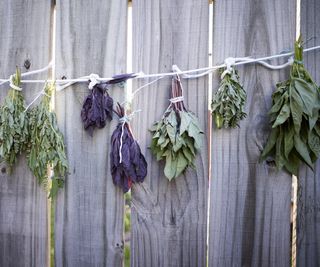Basil is one of the most versatile herbs and can produce a high yield in sunny summer weather. The leaves are a key ingredient in rich pesto sauce and are used fresh in salads, sandwiches and many other recipes.
Basil will continue to grow throughout the summer, meaning it can be harvested regularly throughout the growing season. However, as soon as temperatures start to cool, it will begin to die. Even a light frost can kill it. So what can you do to save all those delicious leaves? Drying basil is an easy and effective way to preserve the fresh flavor of summer, even in the winter.
How to dry fresh basil
Basil has a stronger flavour when fresh, but as anyone who has ever had it in their kitchen knows, it spoils quickly. This is because the leaves have a high moisture content, which means they need to dry quickly to avoid mould. Air must circulate freely around both sides of the leaves for the quickest drying.
Drying fresh basil is an easy way to preserve the fresh flavor of lemon anise to the spicy flavor of pepper. The first step is harvesting.
Harvesting basil for drying
If you are harvesting basil for drying, you should harvest in the morning, right after the dew has evaporated from the leaves, but before it gets too hot. When picking basil, always look for a growth node, or point where the main stem branches off. Sometimes you may even see small leaves starting to grow where the stems intersect. Make sure to cut your basil 1/4 inch (0.5 cm) from one of these growth nodes. This will encourage those small leaves to start growing into larger main leaves that will produce more basil later on.
Remember, basil is full of water and dried leaves will shrink to about half their fresh size, so if you plan on drying them, you should pick twice as many leaves as you think you will need.
There are three quick and effective methods for drying basil.

Large Leaf Italian Basil Seeds
Grow your own basil from seeds from the Gardening Know How Store.
1. Hang the basil to dry

(Image source: michael jarecki / Getty Images)
Air drying may be the slowest method, but I personally find it the most satisfying. To hang dry basil, cut the stems into about 6 inches (15 cm) long pieces and tie them together with string. Continue this until all of your basil is tied into these little bundles, then hang them up to dry in a dark room with low humidity and warm temperatures.
Punch a few holes in the paper bag (for air circulation) and tie it tightly around one bunch. Repeat this until each bunch of basil is surrounded. The bag will catch the dry leaves as they fall, so all your hard work doesn’t end up on the floor.
2. Dry the basil in a dehydrator

(Image source: Helin Loik-Tomson / Getty Images)
If you have a lot of herbs but don’t have a food dehydrator, it might be time to get one.
First, wash the basil, separating the leaves from the stems. Dry the leaves and arrange them in a single layer in the dehydrator. Let them dry in the dehydrator until they are completely crisp. Depending on the type of dehydrator and the temperature you set, this can take anywhere from a few hours to a day.
3. Dry basil in the microwave

(Photo credit: Photographer, Basak Gurbuz Derman / Getty Images)
If you are really short on time, you can dry the basil in the microwave. However, you will have to watch it very closely to avoid burning the leaves.
Separate the basil leaves from the stems, then wash and pat dry. Arrange them in a single layer on a paper towel and microwave on low for about 3 minutes.
While your goal is three minutes, some of the leaves may dry out before that point, and this can lead to a smokey mess. Check their progress every minute (or less!) and remove any leaves that have dried out. This will prevent them from burning.
Preserving dried basil leaves
Dried herbs naturally lose their flavor over time – that’s a given. However, this process happens much faster if they’re exposed to light. It’s best to store dried basil in a dark cupboard or pantry where light can’t reach it.
The container should be dry and airtight. If you have dried any stems or flowers along with the leaves, remove them now. Crumble the leaves so they look like store bought and they will be ready to use in recipes.
Dried basil is more concentrated and tends to be more potent than fresh basil. If a recipe calls for fresh basil, use 1/4 to 1/3 the amount of dried basil to achieve the same results.
This article introduces products available from third-party vendors on Gardening Guide Store.
